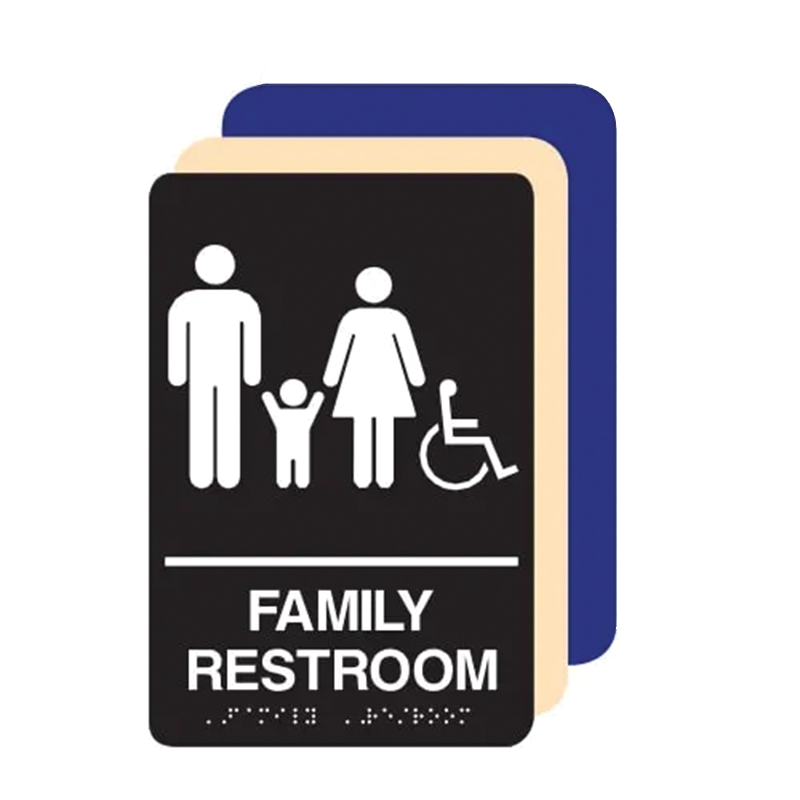ADA Signs: Vital Devices for Inclusive Atmospheres
ADA Signs: Vital Devices for Inclusive Atmospheres
Blog Article
Exploring the Trick Features of ADA Indications for Boosted Access
In the realm of availability, ADA indications offer as silent yet effective allies, ensuring that rooms are comprehensive and navigable for individuals with handicaps. By incorporating Braille and tactile elements, these indicators break barriers for the aesthetically impaired, while high-contrast shade plans and legible typefaces cater to diverse aesthetic needs.
Relevance of ADA Compliance
Making sure conformity with the Americans with Disabilities Act (ADA) is critical for fostering inclusivity and equal access in public areas and offices. The ADA, enacted in 1990, mandates that all public facilities, employers, and transportation services fit people with disabilities, ensuring they appreciate the same legal rights and possibilities as others. Conformity with ADA standards not only satisfies legal obligations however likewise boosts a company's track record by showing its dedication to diversity and inclusivity.
Among the key aspects of ADA compliance is the application of available signs. ADA indicators are designed to ensure that individuals with impairments can conveniently navigate through spaces and structures. These signs must follow specific standards pertaining to dimension, typeface, shade comparison, and placement to assure presence and readability for all. Properly applied ADA signs helps remove barriers that people with disabilities frequently encounter, thus promoting their self-reliance and confidence (ADA Signs).
Furthermore, adhering to ADA regulations can reduce the threat of possible fines and lawful consequences. Organizations that fail to adhere to ADA standards may encounter fines or claims, which can be both economically difficult and damaging to their public picture. Hence, ADA conformity is integral to fostering a fair environment for everyone.
Braille and Tactile Elements
The consolidation of Braille and responsive elements right into ADA signs symbolizes the concepts of availability and inclusivity. These features are vital for individuals that are aesthetically impaired or blind, allowing them to navigate public areas with better independence and confidence. Braille, a responsive writing system, is necessary in providing composed details in a format that can be quickly regarded through touch. It is usually positioned beneath the matching message on signs to make sure that people can access the details without visual aid.
Tactile components expand past Braille and include increased personalities and signs. These elements are developed to be discernible by touch, permitting people to identify area numbers, toilets, leaves, and various other critical areas. The ADA sets specific standards pertaining to the dimension, spacing, and placement of these tactile elements to maximize readability and make certain uniformity throughout various atmospheres.

High-Contrast Color Design
High-contrast color pattern play a pivotal role in enhancing the presence and readability of ADA signage for people with visual impairments. These systems are crucial as they take full advantage of the difference in light reflectance between message and background, making sure that signs are conveniently discernible, also from a distance. The Americans with Disabilities Act (ADA) mandates using specific shade contrasts to accommodate those with restricted vision, making it an essential facet of compliance.
The efficacy of high-contrast shades hinges on their ability to stand apart in different lights conditions, consisting of dimly lit settings and locations with glare. Commonly, dark text on a light history or light message on a dark history is used to accomplish optimum contrast. For circumstances, black message on a yellow or white background supplies a raw visual distinction that assists in quick recognition and understanding.

Legible Fonts and Text Size
When taking into consideration the layout of ADA signs, the choice of clear font styles and proper message size can not be overemphasized. These elements are vital for ensuring that signs are available to individuals with visual disabilities. The Americans with Disabilities Act (ADA) mandates that font styles need to be not italic and sans-serif, oblique, manuscript, very decorative, or of unusual form. These requirements help guarantee that the text is easily readable from a distance and that the personalities are distinct to varied target markets.
The size of the message likewise plays a pivotal duty in access. According to ADA standards, the minimal text height need to be 5/8 inch, and it must boost proportionally with watching range. This is specifically crucial in public spaces where signage demands to be checked out rapidly and precisely. Consistency in message size adds to a natural visual experience, assisting individuals in browsing atmospheres efficiently.
Furthermore, spacing in between lines and letters is essential to legibility. Ample spacing avoids personalities from appearing crowded, boosting readability. By adhering to these criteria, designers can significantly enhance accessibility, making sure that signage serves its designated objective for all people, despite their aesthetic capacities.
Reliable Positioning Techniques
Strategic placement of ADA signs is crucial for making the most of availability and guaranteeing conformity with lawful standards. ADA standards stipulate that indicators must be placed at a height in between 48 to 60 inches from the ground to guarantee they are within the line of sight for both standing and seated individuals.
In addition, indications should be put surrounding to the latch side of doors to allow simple recognition before entrance. This positioning helps people find rooms and spaces without obstruction. In cases where there is no door, indicators should be positioned on the nearest nearby wall. Uniformity in indicator positioning throughout a facility boosts predictability, minimizing confusion and enhancing total user experience.

Conclusion
ADA signs play a vital role in advertising access Discover More by integrating features that resolve the requirements of people with handicaps. Integrating Braille and tactile aspects guarantees essential info is available to the aesthetically damaged, while high-contrast color design and clear sans-serif font styles boost visibility throughout different lighting problems. Reliable placement approaches, such as proper placing heights and calculated areas, further facilitate navigation. These aspects jointly foster an inclusive setting, underscoring the relevance of ADA conformity in guaranteeing equivalent access for all.
In the world of access, ADA indications offer as silent yet powerful allies, making certain that spaces are inclusive and accessible for people with impairments. The ADA, passed in 1990, mandates that all public facilities, companies, and transport services fit individuals with impairments, ensuring they enjoy the same legal rights and chances as others. ADA Signs. ADA signs are his explanation developed to make sure that individuals with specials needs can quickly browse via buildings and rooms. ADA standards stipulate that indicators need to be mounted at an elevation in between 48 to 60 inches from the ground to guarantee they are within the line of sight for both standing and seated people.ADA indicators play an essential function in promoting availability by incorporating functions that attend to the needs of individuals with impairments
Report this page